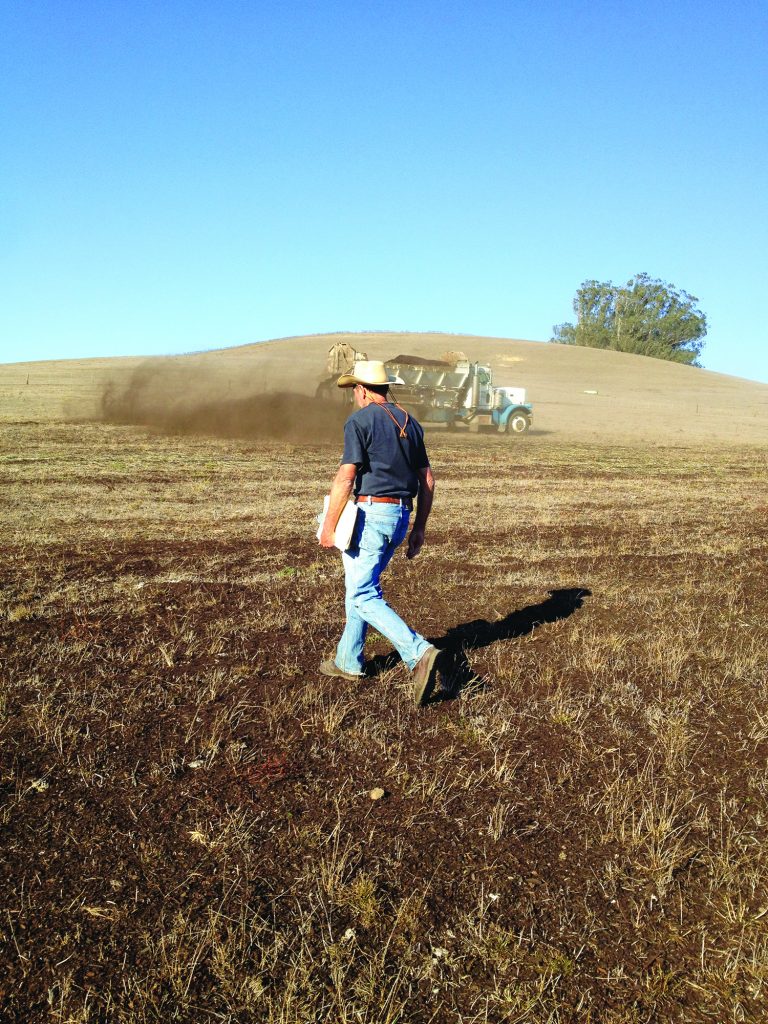
The Marin Carbon Project’s Jeff Creque inspecting compost application at Stemple Creek Ranch five years ago. The impact of this effort will be evaluated this fall. Photo courtesy Marin Carbon Project.
The term “farm” can have more than one meaning these days, especially when it comes to farms fighting climate change. While wind farms are easily recognizable with their giant wind turbines marching across a landscape, a carbon farm is not so easy to spot, given that the fruits of the farm lie in the soil.
A carbon farm is a working landscape, and more. It’s a conservation-based, whole-farm approach that strives to decrease greenhouse gas emissions and increase carbon sequestration while pursuing agricultural production.
Here’s the dirt. Since the Industrial Revolution, the amount of carbon dioxide in the atmosphere has increased by 40 percent, and that is causing record-breaking temperature rises, drought, and dramatic weather events. In response to this global threat, in 2016 California passed Senate Bill 32 (Pavley), setting a 2030 target to reduce greenhouse gas emissions to 40 percent below the 1990 level. The two-fold strategy to meet this target is to reduce the amount of greenhouse gases we put into the air, and to capture some of the carbon dioxide overload that is already there.
Working landscapes can help — if they are managed correctly. Farm practices such as tilling, over-grazing, and applying fertilizers and pesticides can lead to greenhouse gas emissions. On the flipside, if certain strategies are employed, working lands can help to sequester carbon through the process of photosynthesis.
“Agriculture is the art of managing carbon,” said Torri Estrada, executive director of the Carbon Cycle Institute, a Petaluma-based organization that works to stop and reverse climate change. “If every farmer does some work to improve their soil, it gets us closer to shifting agriculture’s contributions to climate change from a problem to a solution.”
While many consider only trees and forests as capturing carbon, a recent UC Davis study found that grasslands and rangelands will likely be more resilient and reliable carbon sinks than trees in the coming century due to increased wildfire risk. In a stable climate, the report notes, forests and trees sequester carbon at a more reliable and measurable rate, but that carbon is released to the atmosphere during a wildfire. Since grasslands and rangelands store carbon in the soil, these systems are more resilient to climate change, drought, and wildfire. Of course, to capture the carbon we have put in the atmosphere, we need all lands on deck.
That’s where a carbon farm comes in. The goal of a carbon farm — in addition to its agricultural production — is to work toward fulfilling the property’s potential to capture carbon and store it in the soil. While too much carbon in the air destabilizes the climate, more carbon in the soil improves fertility, production, and water retention.
Calls for the conservation of soil is nothing new. The USDA’s Natural Resources Conservation Service (NRCS) sprouted after much of America’s farmland soils blew away during the Dust Bowl. The agency has worked with landowners to improve their soils ever since. NRCS has developed a list of conservation practices for greenhouse gas emission reduction and carbon sequestration such as no-till management, riparian forest buffers, waste recycling, anaerobic digesters, and the establishment of hedgerows. The NRCS list of practices also serves as the basis for COMET-Planner, a tool developed by NRCS, Colorado State University, and the Marin Carbon Project.
Organized by a consortium of independent agricultural institutions, the Marin Carbon Project has been advancing the concept of carbon farms for 11 years. Their work began with a multi-year study led by UC Berkeley ecologist Whendee Silver, which in simple terms applied compost to grassland and measured the results. Researchers found that each acre of a three-acre grassland plot treated with a half inch of compost pulled about 1.5 tons of carbon dioxide out of the air per year. To test the application of compost to increase carbon sequestration on a landscape level, the Marin Carbon Project and the Marin Resource Conservation District (RCD) spread it across several hundred acres on three demonstration farms in Marin County. Later this fall they will test the effectiveness of the application begun five years ago.
In addition to applying the compost, the Marin Carbon Project and Marin RCD developed a carbon farm plan for each property. The plans are designed to consider the needs of the landowner while helping to identify conservation practices that improve the health of the soil, cut down greenhouse gas emissions, and sequester carbon. Marin RCD has since expanded its program, developing 15 carbon farm plans and helping with their implementation.
Marin County is not the only place where this is happening; there are now 29 RCDs in California doing carbon farm planning. “Every county has an RCD, and every farm has a portfolio of options,” said Estrada, whose Carbon Cycle Institute has helped fertilize carbon farm plans elsewhere. “In the Bay Area there are 1.5 million acres of rangeland that can be deployed.”
Most RCDs are just getting started. The Alameda County RCD will complete two carbon farm plans with a recent grant from the California Department of Water Resources. “It’s a methodical process,” said Alameda RCD’s Ian Howell. “We will look at practices that improve operations, benefit soil health, and reduce greenhouse gases or sequester carbon. The plan should improve water quality and water retention in the soil, be restorative for the grasslands, and jibe with the economics of the soil.”
Carbon farming is ripe for California’s cap-and-trade market, but there are questions that need answering before the market can take off, said Jasmine Westbrook at Solano Land Trust. In 2016, her nonprofit conservation organization helped launch a study at its Rush Ranch property to highlight the feasibility of using compost application to enhance carbon sequestration on rangeland.
The study at Rush Ranch includes 17 one-acre test plots that received a half inch of compost. The plots have different soil types and grazing regimes. The project complies with the American Carbon Registry methodology and is a partnership of Solano Land Trust, the Carbon Cycle Institute, University of California Cooperative Extension, the US Geological Survey, and the Natural Estuarine Research Reserves.
The movement to support carbon farming isn’t restricted to our region, our state, or our country. In an article for the World Economic Forum, soil scientist David Burton wrote that global farmland restoration could be the answer to climate change and food security. “Improved soil management is a public good. We need economic tools and short-term incentives that encourage producers to adopt these practices for the good of all,” according to Burton.
In other words, farmers and ranchers can’t do it alone. If we are going to turn to them for food, fiber, and carbon sinks, they need our full support in policy and practice.
Aleta George covers open space for the Monitor.

